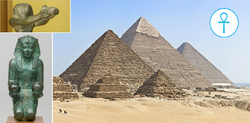- Retour accueil
- Vous êtes ici : Blog The Pyramids of the Cold The Pyramids of the Cold Section 10 • The Impactor
The Pyramids of the Cold Section 10 • The Impactor
Publié par Bruno Coursol dans The Pyramids of the Cold le 12/04/2022 à 20:09
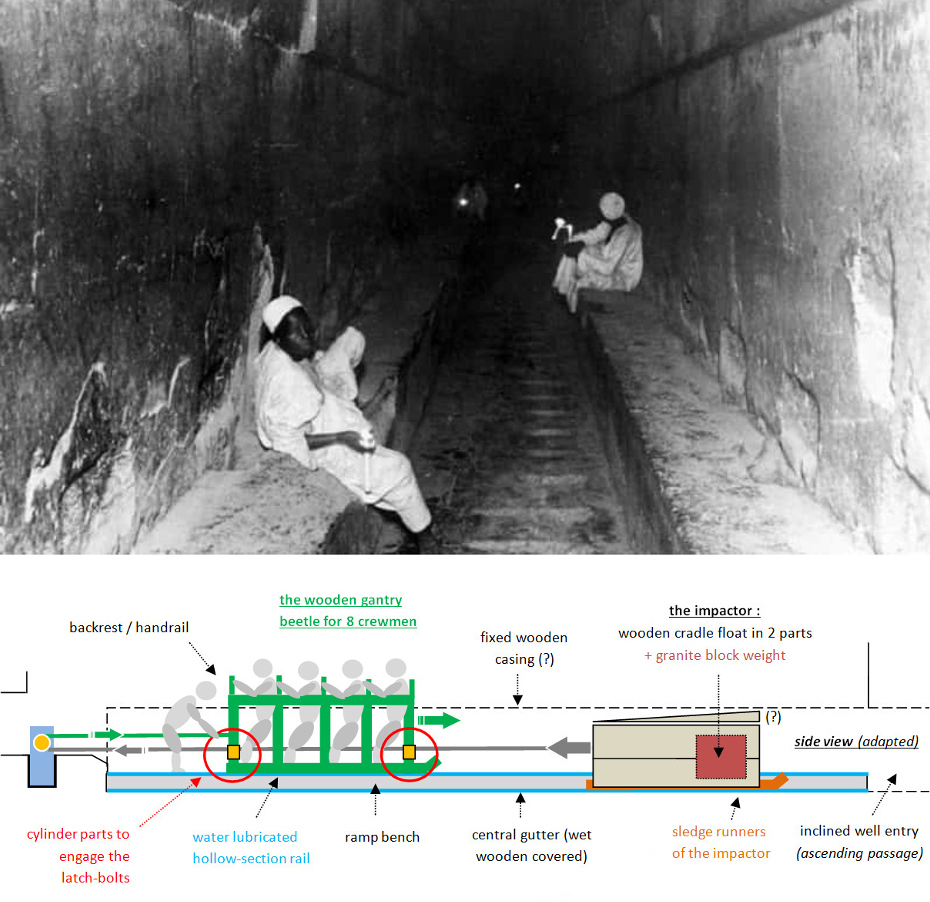
The grand gallery of the Great Pyramid of Khufu at Giza. Please note on the central gutter, the presence of traces, possibly of ancient wooden caisson that, being covered with water, would have allowed the impactor to slide on it like it was ice covered.
The Pyramids of the Cold - Section 10 • The impactor
In summary : the impactor was a moving caisson that was dropped from the top of the Grand Gallery into the inclined well waters, in order to obtain pressurized water that would be redirected towards the evaporative cooling passage.
Made of a wooden cradle float with an inserted granite weight, the impactor was represented in many different ways, based on its weight that caused powerful impacts with the waters of the well (bulls and the horns of a ram), the pressurization of these waters (the Sycamore tree, legs and paws put upon snakes) or even the way that it was getting into the water of the well (the crocodiles).
10.01 The design of the impactor : the imperative specifications
The idea of pressurizing water in order to produce a fog of liquid microdroplets that would evaporate and create cold, "evaporative cold", imply the use of an impactor of some kind that would be "dropped" in that water again and again…
Once you have a pressure resistant container of some kind (the inclined well), the problem is to design an impactor that is efficient enough in pressurizing the well, but also easy enough to operate. And this is why the impactor couldn't just be a stone block : they had to insert this block into a wooden cradle so that they could easily lift the structure by using ropes, and then release it in the slope so that it can gain speed and energy, with no excessive friction.
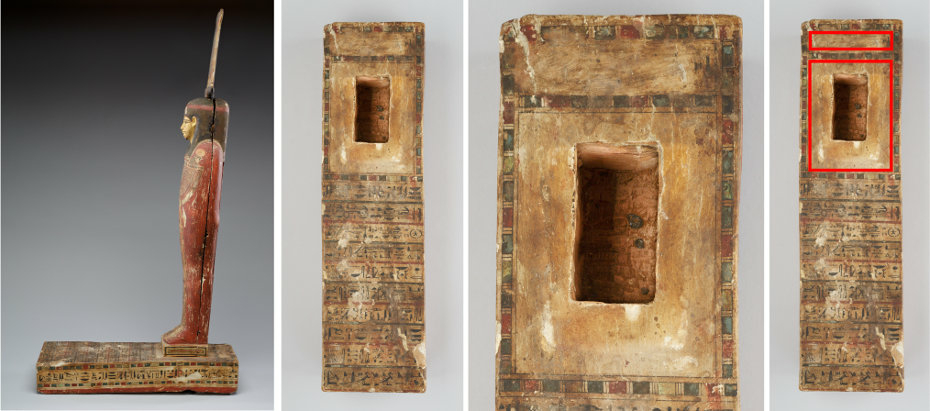
Photograph credit : Ptah-Sokar-Osiris Figure, 306–30 B.C. Metropolitan Museum of Art, New-York. On view at The Met Fifth Avenue.
10.02 The design of the impactor : the wooden cradle float
Hopefully, ancient Egyptians did give to us many representations of the wooden cradle : they are the Ptah-Sokar-Osiris figure bases. Not only do they show us the general shape of the impactor, but some of them are also showing where was inserted the stone block, and it wasn't in the middle, but at the very end of it, near its extremity.
The most interesting Ptah-Sokar-Osiris figure I found is the above artifact "Accession Number: 21.9.1a–c" from the Metropolitan Museum of Art. The entire base of the figure is completely covered with decorations, with 2 exceptions (highlighted in red), side by side : a small blank rectangular shape and a big one.
Even if the small one is still mysterious to me, the big one is in my opinion, still blank, because it was at this exact position that the stone block was inserted in the cradle.
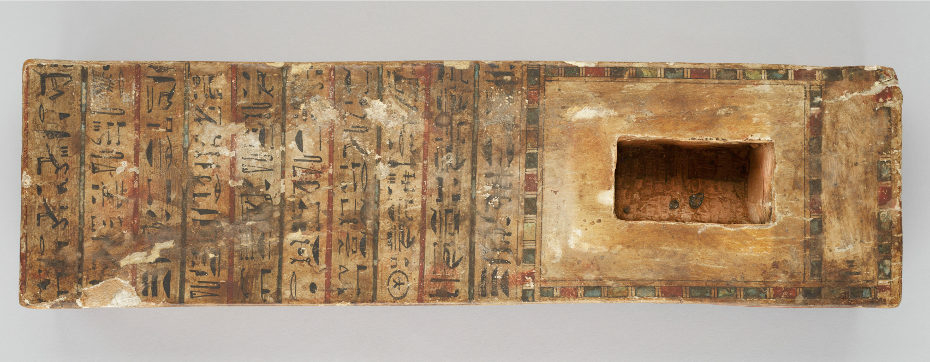
Ptah-Sokar-Osiris Figure, 306–30 B.C. Metropolitan Museum of Art, New-York. On view at The Met Fifth Avenue.
The Ptah-Sokar-Osiris figure bases are representations of the wooden cradle float that was operated in the Great Pyramid
It is important to note that this big rectangular shape, is not blank of any decoration because it would be covered with the feet of the figure anyway : the blank rectangular shape is much bigger that the imprint of the feet onto the figure base, and the mummy had clearly let a imprint inside that rectangular shape, that appears in a different yellowish color around the hole.
That figure base though, would be set right on top of the representation of the stone block : the figure bas would have been associated with the power and the force of the inserted stone block.
And that is precisely what some figures of Imhotep are showing : Imhotep standing of what looks like a granite block.
This why, even if I'm not sure of it, I would think that the inserted stone block was made of granite : the impactor had its power from a granite block.
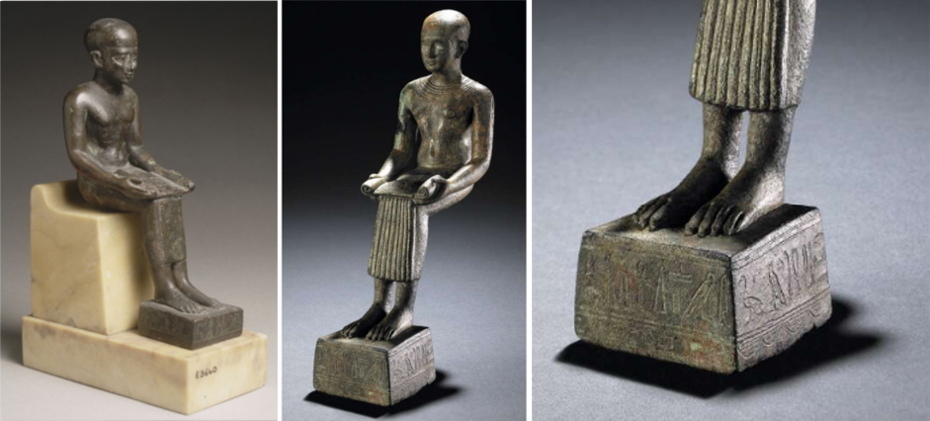
Left : Figurine of Seated Imhotep E3640 from the Louvre Museum. Date de création/fabrication : Basse Epoque (attribution d'après style) (-664 / -332 BCE). © Musée du Louvre / RMN-Grand Palais / Hervé Lewandowski. Second image : figure of Imhotep EA40666 from the British Museum.
10.03 The design of the impactor : the inserted granite block (alone)
Imhotep was a scientist, an architect and an engineer, so we shouldn't be surprised about the way he is depicted in his seated figurines : he holds the knowledge in his hands, seated with his feet in contact with what represented the most important piece of the Great Pyramid operating, the granite block that was inside the wooden cradle float.
We could argue that the "Imhotep's stone" is not the granite block that was inserted inside the wooden cradle float, and that it was just representing the fact that Imhotep was the first architect to use stone blocks instead of bricks.
But I don't think it is : on the Metropolitan Museum figurine of Imhotep donated by Padisu (previous set of photographs above), this block quite doesn't show at all, and it is pretty much absorbed by the base, which I believe is the cradle, but here it doesn't really matter.
If the intent was to show a block because Imhotep used blocks, they wouldn't have quite completely hide it.
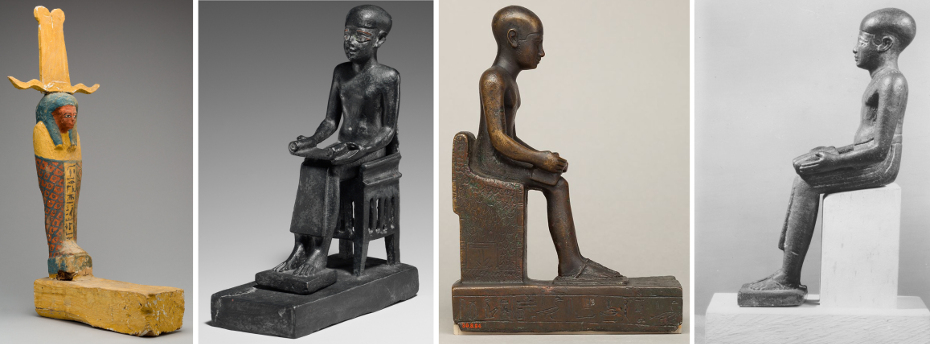
Left : Ptah-Sokar-Osiris Figure of Ankhshepenwepetca from the Metropolitan Museum. (712–664 B.C. Third Intermediate Period). Second photograph : Statue of Seated Imhotep from the Metropolitan Museum (332–30 B.C. Ptolemaic Period). Third photograph : Imhotep, donated by Padisu (664–30 B.C. Late Period–Ptolemaic Period). On view at The Met Fifth Avenue in Gallery 134. Right : Seated Statuette of Imhotep from the Brooklyn Museum. On View: Old Kingdom to 18th Dynasty, Egyptian Galleries, 3rd Floor.
10.04 The design of the impactor : the inserted granite block (within the wooden cradle float)
On the above photographs of Imhotep and Ptah-Sokar-Osiris figures, what is interesting to see is how is implemented the granite block in the design of the figures. Some of them are showing a big portion of it, while in others, the block is almost completely not showing at all, but still present.
Of course, the last picture from the Brooklyn Museum is one of my favorites, because it only shows the granite block, alone, without the wooden cradle float.

Left : Ptah-Sokar-Osiris Figure of Ankhshepenwepetca from the Metropolitan Museum. (712–664 B.C. Third Intermediate Period). Second photograph : Statue of Seated Imhotep from the Metropolitan Museum (332–30 B.C. Ptolemaic Period). Third photograph : Imhotep, donated by Padisu (664–30 B.C. Late Period–Ptolemaic Period). On view at The Met Fifth Avenue in Gallery 134. Right : Seated Statuette of Imhotep from the Brooklyn Museum. On View: Old Kingdom to 18th Dynasty, Egyptian Galleries, 3rd Floor.
10.05 From Imhotep's "Refreshment of the Gods" Pyramid... to the "Pyramids of the Cold"
Imhotep biggest influence was not in the medicine field, but in architecture. He is the one who built the first true pyramid in ancient Egypt, made of stone blocks and not dried mud bricks : the Djoser's Step Pyramid. Interestingly, this unprecedented step pyramid was called "The Refreshment of the Gods" ; and that obviously echoes the evaporative cooling process used in the Great Pyramid.
My conviction is that the term "refreshment" is not fully accurate: Imhotep's first pyramid was certainly not the "refreshment pyramid", but "the Pyramid of the cold".
Ancient Egyptians didn't master an ammonia Solvay-like process overnight : it had to be a long experimental journey, over many generations (the Disc of Sabu is dated from the First Dynasty, 3100 BCE to 3000 BCE ; and the Djed Pillars from even before that). Most probably, their biggest challenge from the beginning was cooling down the reaction chambers.
It is certainly not by accident that Imhotep not only was the first one to build structures out of limestone blocks, but also the first one to add columns to their design. Columns echoes to the Solvay towers but also to modern cooling towers (read the post about Sneferu's Red and Bent Pyramids for more on the subject).
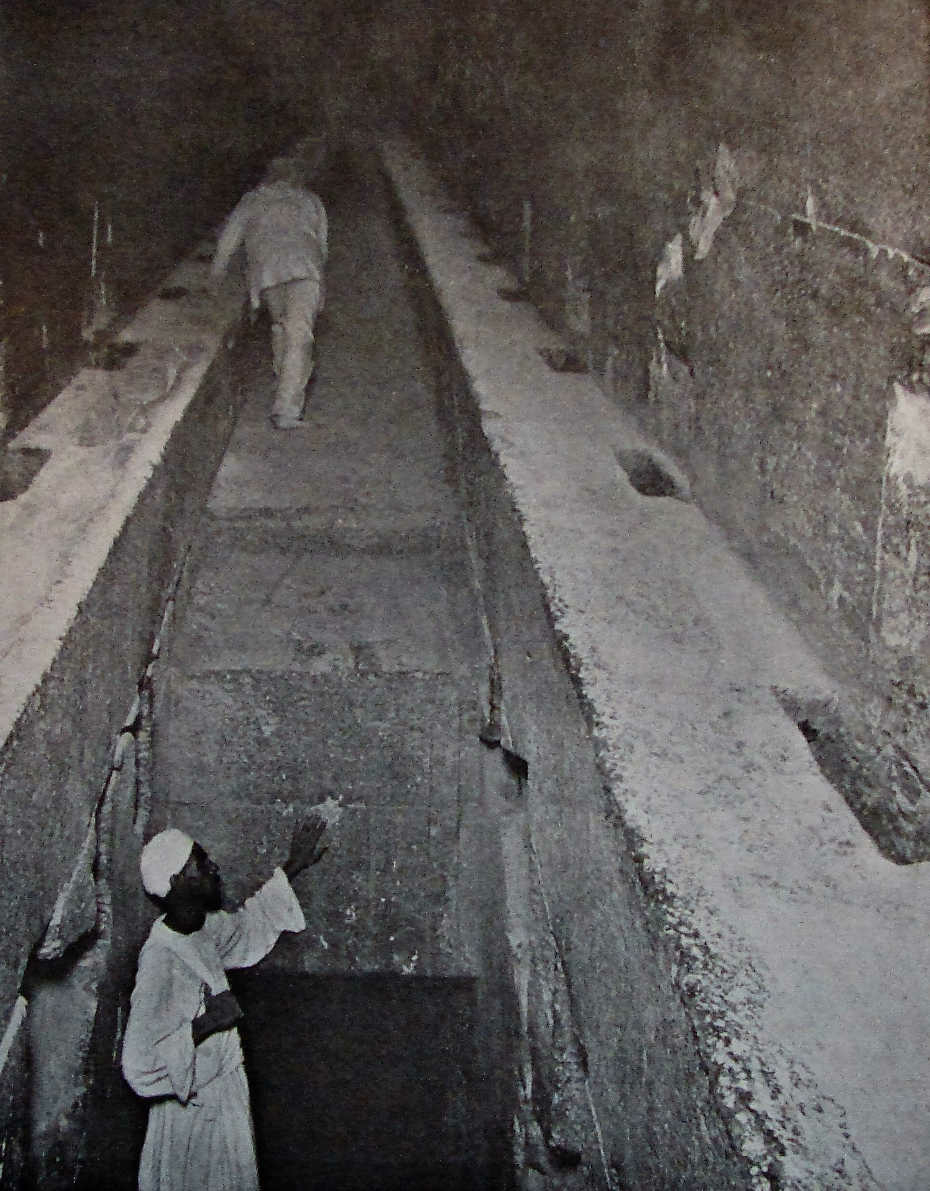
The grand gallery of the Great Pyramid of pharaoh Khufu at Giza, Egypt. Source: The Great Pyramid Passages And Chambers" Volume 1 by John and Morton Edgar, 1910 : https://archive.org/details/GreatPyramidPassagesVol11910Edition/page/n299/mode/1up
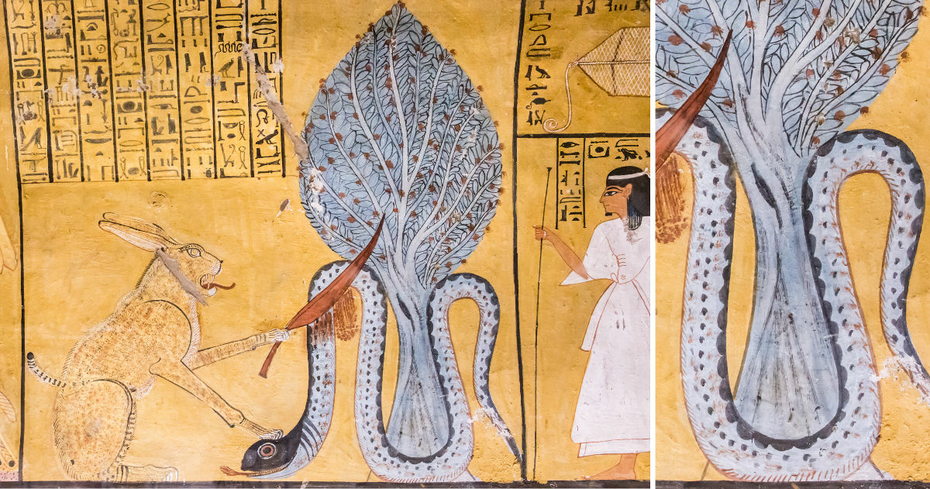
The representation of the pressurization of the inclined well waters of the Great Pyramid of Giza, by putting the Sycamore tree weight upon Apep, that represented the waters of the well themselves. Look how the Sycamore tree trunk is completely enveloped by the body of the snake (snake = water) and how pinned down by the Sycamore tree is the snake.
Overthrowing of Apep in the Theban Tomb TT359, located in Deir el-Medina, part of the Theban Necropolis. It is the burial place of the ancient Egyptian workman Inherkhau, who was Foreman of the Lord of the Two Lands in the Place of Truth during the reigns of Ramesses III and Ramesses IV (Wikipedia). Original image thanks to kairoinfo4u, and posted on flickr : https://www.flickr.com/photos/manna4u/18578810231/in/photostream/
10.06 Pressurization of the inclined well metaphor 1 : the sycamore fig tree upon Apep
This metaphor of the impactor is about its weight and the pressure it is causing.
The sycamore fig tree that appears with Apep has raised some problem until I stopped thinking about it in a "static" way and completely disconnected from the cutting made by the cat on the left part of the image.
We've seen that Apep is a metaphor of the inclined well waters, and that it's cutting is a representation of the small amount of pressurized water getting out of the well.
On this image, the cut is made right in front of our eyes : it means that the well is pressurized. The presence of the sycamore fig tree has to tell us what is causing the pressurization.
1 • If we look closely, the trunk of the fig tree seems to be completely surrounded by the body of the snake, and nearly absorbed by it. The snake (the water) is all around the trunk : the sycamore tree is immersed into the water.
2 • Also, it almost looks like Apep had been punched down by the tree and he is held down on the ground like fighters would do. The weight of the trunk is constraining the body of the snake : that is the representation of the pressurization of the water.
The trunk of the sycamore is a metaphor of the impactor getting inside the inclined well (represented by the body of the snake) and pressurizing the well.
The sycamore fig tree is the impactor.
10.07 The interlocked fibers of the Sycamore wood Ficus sycomorus* and its high hit resistance
Knowing that the sycamore fig tree was a representation of the impactor, we now have to ask ourselves if that impactor was made from sycamore fig wood or if this is another metaphor.
From the Majofesa website, about Ficus sycomorus* : "The sycamore wood is one of the toughest that exists in the timber market, according to hits, weather and time. It even acquired a sacred value thanks to its durability, as the Pharaohs and the most powerful men of the Ancient Egypt wanted their sarcophagi was built with this material to be preserved better and longer. It was believed that in time their mummies would reach a sacred aspect."
"The sycamore wood is heavy, moderately hard and strong. Its fiber is straight, occasionally wavy, and the grain is fine and uniform. The sycamore wood is easy to work because of its linked fibers, which allow breaking and cutting it easily. It supports very well the gluing, screwing and nailing, and the finish is usually great. Sycamore has a fine and even texture that is very similar to maple."
"The grain is interlocked."
In other words, the Sycamore would have been a perfect candidate for the purpose of the impactor : its interlocking fibers make this wood very hit resistant.
*Ficus sycomorus, not to be confused with unrelated trees. From Wikipedia : "The term sycamore spelled with an A has also been used for unrelated trees: the Great Maple, Acer pseudoplatanus, or plane trees, Platanus. The spelling "sycomore", with an O rather than an A as the second vowel is, if used, specific to Ficus sycomorus."

Image on the left : the snake god Nehebkau (also spelled Nehebu-Kau), Spell 87 from the Book of The Dead. https://en.wikipedia.org/wiki/Nehebkau. Center : The Spearing of Apep (From the Papyrus of Nekhtu-Amen).
10.07 Pressurization of the inclined well metaphor 2 : the legs, feet and paws upon Apep
This metaphor of the impactor is about its weight and the pressure it is causing.
Here, it is the same kind of association with the legs and the snakes : legs are also referring to the weight that is putting pressure upon snakes (upon water), whether they are onto the snake, or under the snake, like with Nehebkau (above).
It is amazing and fascinating to see that logic can be completely forgotten and different pieces of the puzzle voluntarily misplaced. This treachery obviously has the only intent to give us misleads. The positions of the legs under the snake and the Sycomore tree just next to Apep instead of onto Apep, in many representations are precisely that : misleads.
One could try to decipher the serpent walking on human legs, forever, he'll never understand the trick : the real meaning of the legs are about pressure upon something. Legs should be represented onto the serpent like on the second above image, not the opposite.

Tomb KV9 of Ramesses V-VI. Fourth corridor, decoration on left wall: ninth division of the Book of Gates. Photograph by R Prazeres, on Wikipedia
10.08 Pressurization of the inclined well metaphor 3 : the full body weight upon Apep
This metaphor of the impactor is about its weight and the pressure it is causing.
This scene from Ramesses KV9 tomb, is also a representation of the pressurization of the inclined well. This time, this is not the impactor that is used to put weight on the body of the snake, but the characters themselves. Probably they are also meant to represent the cutting of the snake in equal length segments.
10.09 Apep and the combination of 4 different metaphors
In my opinion, the metaphors about Apep are the most striking of all the metaphor combinations used by ancient Egyptians I know of, and it is in 4 acts :
1 • The metaphor of the pressurization of the inclined well : the sycamore tree
2 • The metaphor of the pressurized waters : the Great Serpent Apep
3 • The metaphor of the pressurized waters containment : the restraining of Apep by the ropes (see farther below).
4 • The metaphor of a portion of the pressurized water injected into the cooling passage : the Great Serpent Apep cutting and the Mehen artifacts
What all this metaphoric art is saying about the ancient Egyptian lost civilization is really admirable. I already had the utmost respect for the beauty of the Great Pyramid functioning and its marvelous impactor operating cycle, but I am starting to believe their artistic capabilities were at least equally outstanding.
The fact that their extraordinary extremely high sophisticated society was so diminished by modern people is totally beyond me. In all honesty, we should be ashamed of ourselves.
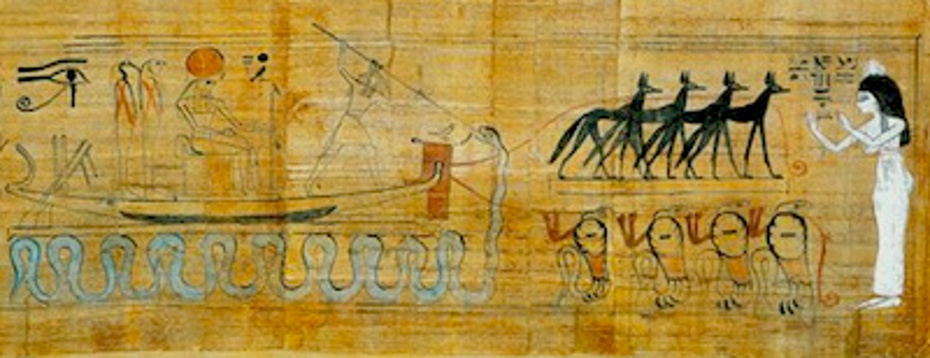
10.10 Sliding movement in the central gutter of the Grand Gallery metaphor : the Solar Barque
This metaphor of the impactor is about its movement into the central gutter of the Grand Gallery.
The solar barque was used as a representation of the impactor because it was moving inside the central gutter of the gallery on a film of liquid water, exactly like a water slide ; while the Ptah-Sokar-Osiris figure wood bases were used to reproduce the actual shape of the impactor.

Left image from the Rhode Island School of Design (RISD), Providence : Ptah-Sokar-Osiris / wood, gesso, and paint, 332-30 BCE. Second and third images from the Metropolitan Museum : 86.1.88a–d and 25.3.204. Last image from National Museums Liverpool : 1973.1.685
10.11 Shocks and impacts with the waters of the well metaphor : the Ptah-Sokar-Osiris ram's horns
This metaphor is about the shocks that the impactor induced when hitting the waters of the inclined well.
The ram's horns significance is one of the easiest representation of the grand gallery operation to comprehend : the entire process was to make the moving caisson ram into the water of the inclined well, so that its energy would be converted into pressurized water directed to the horizontal cooling passage.
The moving caisson was an impactor for the inclined well water.
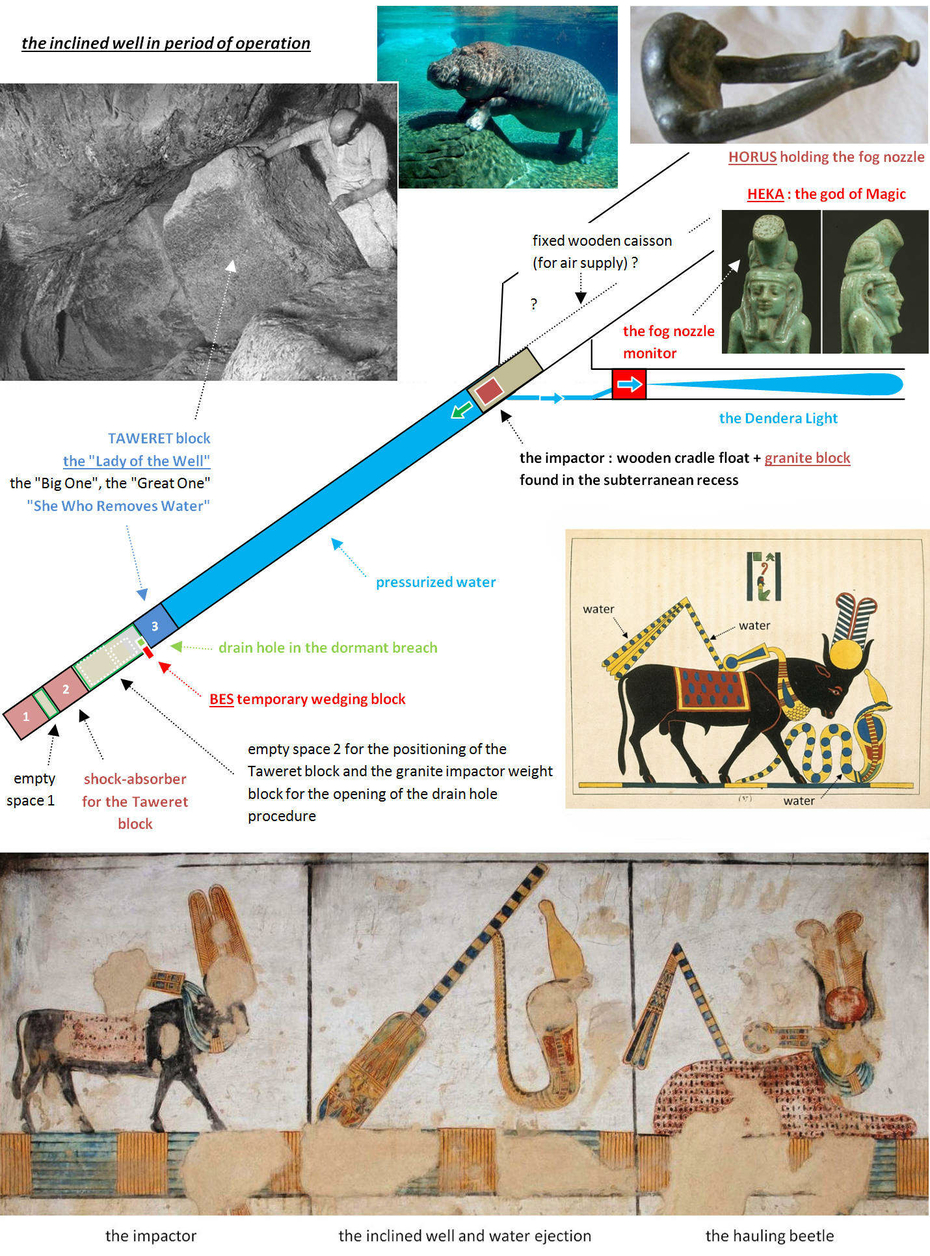
10.12 The strenth and power metaphor of the impactor : the bull representations
• The Apis Bull is a representation of the impactor
The Apis Bull drawing made by J.F. Champollion is a gold mine, because from this drawing we can conclude that the Bull is a representation of the impactor.
Not only the splashing water cannot be atributed to anything else than the impactor running down the Grand Gallery at full speed (around 60 or 65 km/h, or 40 miles per hour, maybe), but the front part of the drawing is also exceptionnal, because it is showing the pressurization of the water by the impactor.
• The Apis bull walking onto the snake... and the water passing through that snake
On the Apis Bull drawing made by J.F. Champollion, it looks like the feet of the Bull are put just next to the snake, but the real meaning is that they are put onto the snake.
It is here the same metaphor ancient Egyptians used about putting weight upon the Great Serpent Apep (whether it is the weight of a sycamore tree, of entire human bodies or just legs).
The Apis Bull is putting its weight upon the snake.
And as a result, water is passing through the snake : the blue dots onto the flail and onto the snake are a representation of the water passing through them.
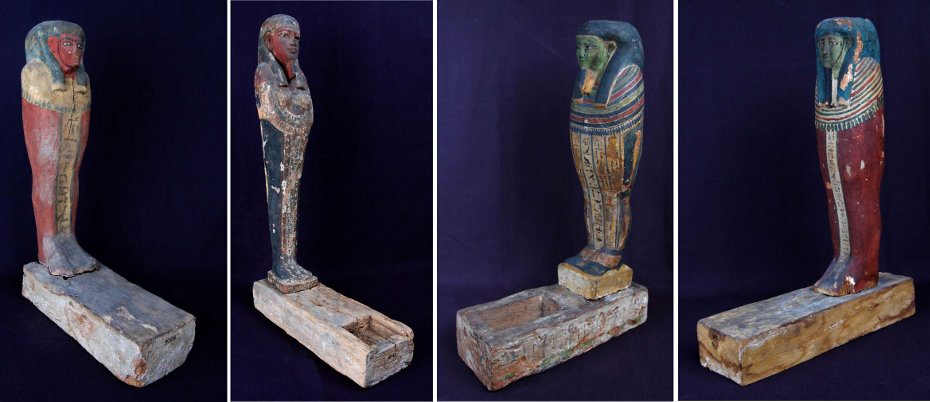
Photographs from the British Museum. From left to right : EA9768, EA9743, EA23046 and EA9757.
10.13 The toy cars analogy
I suspect that some of these Ptah-Sokar-Osiris figures were used like kids play with toy cars today, and that it was mimicking the original caisson movement inside the gallery. It would explain why so many bases of the figures are so worn out, compared to the standing figures themselves.
It is certainly not by accident that the figure itself and the Sokar hawk are not fixed to the base, but are removable.
The mummy would have been positioned looking towards the top of the gallery, slowly ascending the slope, but once on top, it would have been turned over for the descent.
10.14 The recovery of the impactor
Was the wooden cradle float efficient enough to make the impactor really floats at the surface of the inclined well waters or was it only floating in mid-water, I couldn't say. Maybe the goal was only to avoid the impactor to hit the Taweret block that was the bottom of the well.
If a fixed wooden caisson was implemented, they first had to open a small section of it at the bottom of the gallery so that they could reattach the impactor to the central rope before it could be moved back to the top of the gallery.
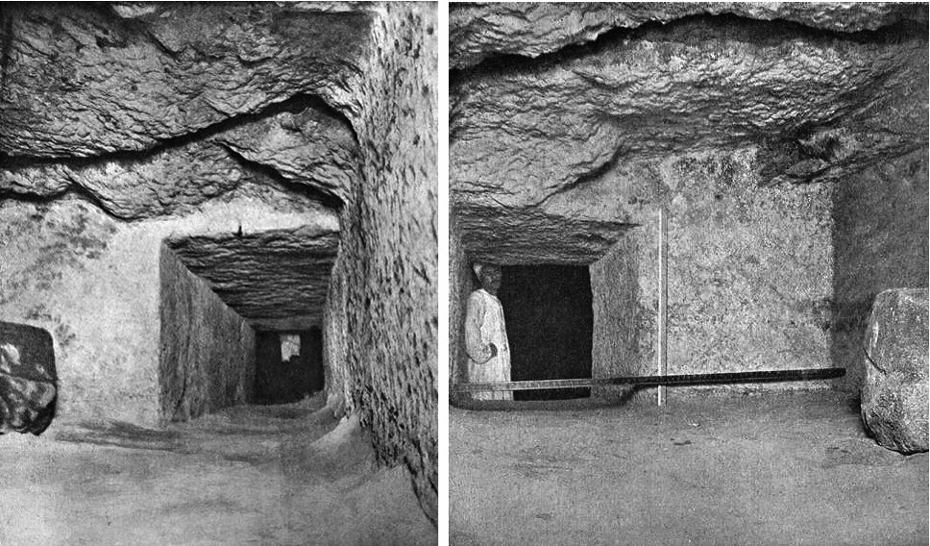
Left is the north part of the recess looking north towards the descending passage, a block on the west side. Right is the south part of the recess with the entry to the subterranean chamber, a block on the west side. The 2 blocks really look different, but apparently everybody says that it is the same block.
10.14 The granite block found in the recess of the subterranean chamber
The question now, is to determine which granite block was inserted into the cradle, even if we still have to consider the possibility that the block probably didn't really need to be made of granite : it would have been completely protected inside the cradle and so, could have been probably made of limestone as well.
If the weight was made of granite, we have 4 granite blocks that could have been used inside the cradle, but I am still wondering if the 2 photographs above are showing the same block or not. For now, the only data I have are as follows :
1 • the granite block located inside the recess of the subterranean passage that leads directly to the subterranean chamber. Dimensions : 64.77 cm x 50.8 cm x 43.18 cm, and no holes. (25.5 inches x 20 inches x 17 inches)*.
This block is the only granite block found in the Great Pyramid passages, with no holes. In my opinion, it is the block that was inside the moving caisson. Its volume : 0.142 m³. Considering 2700 kg / m³, the recess granite block would weight about 380 kg.
2 • the granite block, called Petrie's Block, on which an iron grill-door had been fixed inside the descending passage. About this stone, Morton Edgar says : "Although the large granite block on which the grill-door is fixed, takes up nearly the full width of the passage, it did not interfere with our work". Source : Great Pyramid Passages Volume 1 1910 edition by John and Morton Edgar (section 287, page 142). Dimensions : 80.01 cm x 53.34 cm x 11.76 cm, and 3 holes*.
3 • the granite fragment on the ledge of the subterranean pit, with 2 holes*. Dimensions unknown to me.
4 • the granite block in the grotto. Dimensions : 53.34 cm x 45.72 cm x 43.18 cm, and 2 holes*.
In conclusion : the granite block found in the subterranean recess was most probably the one used inside the impactor.
* Source : Pyramids of the Giza Plateau: Pyramid Complexes of Khufu, Khafre, and Menkaure, by Charles Rigano.
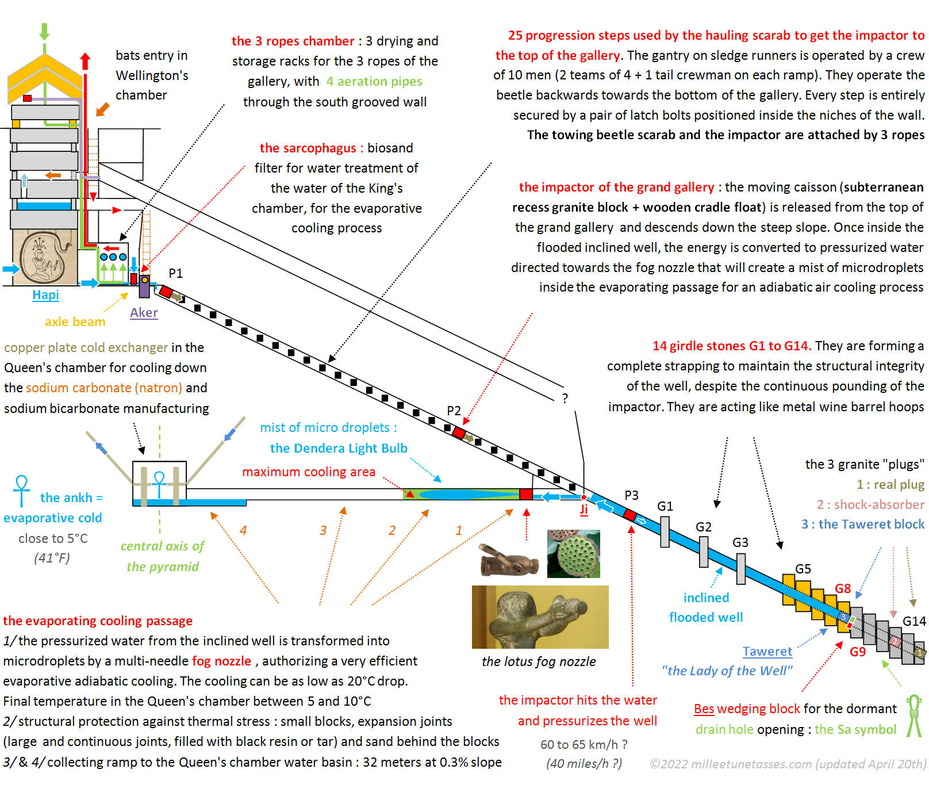
Diagram of the Great Pyramid of Egypt in operation, before the shutdown procedure and the draining of the inclined well.
10.15 Summary of the study : hidden behind the academic vision of the ancient Egyptian religion, a vast number of metaphors are describing some of the most advanced science and technological knowledge of that time : ancient Egyptian gods were nothing else than pharaohs' metaphoric self-glorifications of their theoretical and experimental scientific accomplishments in physics and chemistry.
Pharaohs used the power of Science to legitimate themselves as kings of Egypt : they forged an entire religion, based on science to rule their kingdom, and they presented that science as Magic.
The end game of this technological program that probably started on the very first Dynasty, was the Great Pyramid of Giza where evaporative cooling was engineered in the known part of the pyramid from the pressurized water produced in the inclined well, known today as the ascending passage.
The evaporative cold simply took advantage of the power of water, and was most probably necessary to cool down chemical manufacturing of sodium carbonate and sodium bicarbonate produced by an ammonia-soda Solvay process, as suggested by the very strong ammonia smell and the limestone kiln in the so-called burial chamber of the Red Pyramid. At that time, sodium carbonate was called natron, and it was the salt used for the mummification of the pharaohs (Sections 14, 15 and 16).
The cooling seems to have represented the most difficult part of the process, as suggested by the Step Pyramid's official name : according to scholars, the very first pyramid complex, the Step Pyramid of Djoser, was called "the refreshment of the Gods". No doubt that a more accurate translation would certainly be "the cooling of the Gods".
It means that ancient Egyptians were the first civilization to master a Solvay-like process for sodium carbonate manufacturing, long before it got reinvented in the 1800's in Europe. The key elements of that process is the temperature control of the chemical reactions (the cooling), and the dome shaped plate necessary for the counterflow chemical reactions to occur in an efficient way. That counterflow reaction plate is what really is the disc of Sabu.
As shown with Akhenaten and Nefertiti, the creation of the evaporative cold was the most sacred accomplishment of all (Section 17), and this is exactly what the Dendera Light is all about : the Dendera Light is the fog of microdroplets of liquid water that evaporates and creates the cold. Talking about the snake inside the Dendera Light Bulb : "The field surrounding Ra’s snake form is referred to in ancient Egyptian literature as protective magical energy in liquid form that all gods and pharaohs possess" (Faulkner, Section 2).
Everything that had been done in the Great Pyramid of Giza inspired most of the ancient Egyptian religion, and it had been glorified into what we know today as the Underworld.
The Underworld is referring to the chambers and passages of the Great Pyramid of Khufu, and in particular to the Grand Gallery where a hauling gantry beetle operated a wooden coffin shaped impactor that had a small nested granite block inside it. The impactor generated endlessly, over and over, maybe every 15 minutes the pressurized water that was then transformed into a fog of microdroplets inside the horizontal cooling passage.
The Grand Gallery of the Great Pyramid where the act of hauling was done, is the "Secret Hauling Cavern of the Underworld" described in the Amduat "Book of the Hidden Chamber".
The most important chamber of the Great Pyramid wasn't the King's chamber that only was the main water tank of the pyramid, but the Queen's chamber, the only one on the central axis of the pyramid. Because the Queen's chamber was inaccessible from the rest of the pyramid, it was glorified into the "Hidden Chamber of the Underworld" (Section 11), and because the Queen's chamber was the coolest place in the pyramid (about 5°C / 41°F), and with a constant 100% Humidity rate, this chamber was the one where the biggest amount of very hard salt encrustation had been documented by the first explorers of the pyramid in the 1800's and before it had been removed in 1998 by Zahi Hawass (Section 1). Very hard salt encrustation is the signature of the evaporative cooling process, even nowadays.
The most incredible thing is that pretty much everything I've just said, actually appears in one single myth, but it doesn't originate from ancient Egypt : it is the "Churning of the Ocean" Hindu myth that produces the immortal nectar Amrita. The fact is that the endless churning of water that ends up with the production of an elixir that gives eternal life, is exactly what were doing ancient Egyptians in the inclined well : natron was the salt used for the mummification of pharaohs.
Natron gave eternal life to pharaohs, just like the Amrita (Section 19).
Bruno
Hello Sagi,
I thought that too, but I changed my mind because of the speed of the impactor : they most probably didn't want the rope to slide down at let's say 65 or 70 km/h, because of the friction on the floor of the gutter, even wooden covered, and because when the impactor hits the waters, it is suddenly stopped and the rope would have crashed the same way, whether on the back of the impactor or onto the waters.
Poster un commentaire

